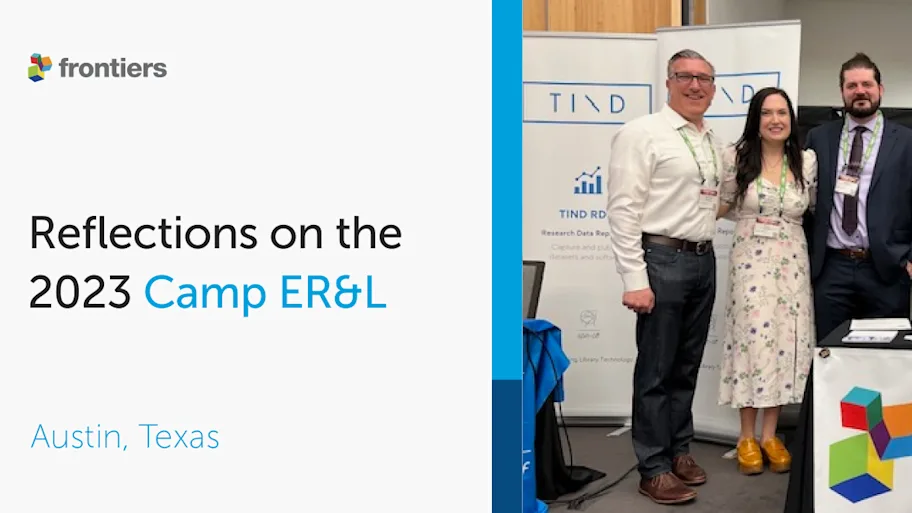
- Science News
- Frontiers news
- Unlocking US science for healthy lives on a healthy planet
Unlocking US science for healthy lives on a healthy planet
Frontiers Briefing Note
OSTP Guidance to Make Federally Funded Research Freely Available without Delay

Introduction
On 25 August 2022, the White House Office of Science and Technology Policy (OSTP) unveiled vital new policy guidance to make the results of federally funded scientific research in the United States immediately free to access and available to all. We strongly backed that guidance and we outline here our thoughts on implementation.
Frontiers is a leading research publisher, the 3rd most-cited and 6th largest in the world. We publish ground-breaking discoveries by the world's top experts. We are fully Open Access (OA) and have been since our inception in 2007. The research we publish is fully and immediately available, without embargo.
We have a global footprint and in the US are growing. 46,000 American scientists serve on our editorial boards, and we have published over 90,000 papers by US researchers.
We bring full and immediate access to high-impact, peer-reviewed science in an economically viable model that is scalable. And we seek to share our experience of publishing fully OA journals to help shape the best public policy outcomes.
We stand ready to support partners – such as libraries and societies – in the vanguard of the vital transition described by the OSTP's guidance. Coordination amongst all stakeholders will be key to success.
We have already partnered with societies and established commercially successful models that support high-quality research. It is possible to meet the appetite for fully accessible knowledge with a business model that is cost-effective, sustainable, and that matches the vision of the OSTP. In addition, we have close to 650 institutional partnerships and are working hard to meet the call for the deeper, faster collaboration driven by fully accessible science.
Our response
The OSTP’s guidance, if properly implemented, will herald a new era of world-class science that draws on the power of digital scholarly communication in the 21st century to disseminate knowledge immediately and freely to all.
This progressive policy will also help create a more diverse, competitive market that more equitably serves the American people, its economy, and its scientific breakthroughs.
This policy extends a vision we fully support for the following, principal reasons:
1. We need access to the latest scientific knowledge – all of it – to live healthy lives on a healthy planet
Global, existential threats – from health emergencies to climate change – can be reversed and managed with political will, greater collaboration, and scientific breakthroughs at scale and pace. But we will need access to the latest scientific knowledge – all of it. The Covid emergency taught us that when we open and share scientific knowledge on a global scale, we can innovate and save lives. The fast, record-breaking development of effective Covid-19 vaccines would not have been achieved without sharing of scientific data and research results through initiatives such as the CORD-19 Open Research dataset, made possible by OSTP vision and leadership in 2020.
The same is true for the equally urgent developments needed to tackle climate change, and – as President Biden made clear recently when announcing the ‘Cancer Moonshot’ initiative[1] – to find cures for cancer. Yet, most of the science that could drive those developments still sits behind paywalls. The political leadership shown by the OSTP is a crucial step to change that.
2. Scientific knowledge, freely accessible, will help drive up equity and equality in the US
The American people fund billions of dollars of research a year but are too often locked out of the chance to see its results. The same is true of the small businesses unable to pay for access. The record is still dominated by subscription-based science. Two thirds of the world’s research sits behind paywalls.[2] It is not fully accessible. It is notable that libraries, long committed to ensuring access to knowledge, are clear in their support for this guidance, as indicated by the immediate response of the Association of Research Libraries.
3. American research, when published Open Access, will grow in reach and impact
OA publishers rank highly on industry measures of impact and reach. Studies repeatedly show that OA articles generate wider readership, greater research impact and more citations than articles sitting behind paywalls.[3] With clear policy to ensure research and data come in an interoperable, machine-readable format for re-use by anyone, American scientists can maintain and solidify their global leadership in innovation and collaboration.
4. American scientific researchers will benefit from high quality
In a fiercely competitive landscape, OA publishers carry the same reputational risk for high editorial standards as subscription-based publishers. In addition, for each article published, most OA publishers bring further transparency by displaying immediately the details of peer reviews, reviewers, and editors. In a free market, authors vote with their feet.
5. Access to science does NOT weaken US Intellectual Property
Providing access to published research articles does not weaken the protection of Intellectual Property (IP) nor lead to the disclosure of sensitive information. IP is protected by patents which must be filed before any public reporting of research results at conferences or ultimately as published articles, regardless of whether they are published in a subscription or OA journal. Paywalls do not protect US IP, since anyone intent on abusing IP will not be prevented by a paywall. However, paywalls hold back innovation and block the supply chain of information.
6. Federal agencies can achieve better value for money in a more diverse market
The worldwide scientific publishing market is estimated at about US$ 26.5 billion in 2021.[4] It is dominated by five large publishing houses,[5] who between them have captured more than half the market.[6] Most of the science they publish sits behind a paywall.At the same time, while the costs of science publishing vary enormously, the average price of an article in a subscription-based journal is still significantly higher than it is in OA journals. In our analysis, the revenue generated by a subscription article ranges from US$4,000 to US$9,000; while the weighted mean Article Process Charge for an article in a hybrid journal is US$3,400 and in a fully OA journal US$2,370.[7]
From our perspective, the policy’s implementation should maintain three guiding principles.
1. A successful public access strategy will be supported by OA publishing services
OA publishers offer editorial services that can effectively and immediately support Federal Agencies in their implementation of the OSTP guidance. Publishing in an OA journal immediately facilitates the transfer of articles to a repository, in machine readable formats. In this model, there are no embargoes, no costly bundled services that are in the end not required, and no call for expensive hybrid options to secure the vision of the OSTP. OA publishers offer a simple, transparent, and cost-effective way for repositories to meet the need for fully accessible science. And with this new guidance, a national repository will achieve the critical size needed for a truly comprehensive collection of openly available articles – a tipping point in open science.
2. Implementing agencies can leverage the ROI as they empower authors and institutions
The guidance gives federal agencies the tools to empower institutions and authors to choose how to publish their research, to benefit the research community and society. Agencies should encourage institutions to release the substantial funds tied up in subscriptions to paywalled journals and redirect them to fund OA publications instead. This will help drive up the returns of taxpayer-funded investment – financially, economically, socially, and critically, in terms of innovation. With the right policies and incentives in place, agencies will drive this logical and just policy guidance to delivery.
3. Government must call out ‘hybrid’ platforms that are prolonging the paywall model
The OSTP acknowledges that subscription-based publishers are seeking out ‘hybrid’ models. Our recent paper sets out why, in our view, those models are perpetuating the paywall and tying up large amounts of public money in the process. So called ‘Transformative Agreements’ are not driving the vital transition to fully accessible knowledge. They make no contractual commitment to the move to full OA with a binding deadline. And they distort competition, partly by entrenching the market dominance of the five largest publishers behind a paywall. The OSTP is seeking equity in access, transparency, and economic sustainability. OA publishers can offer all three.
In short, at Frontiers, we stand ready to support partners to see the guidance implemented. It is vital we back this effort for open science and meet the public appetite for accountability, transparency, and trust.
- - -
About Frontiers
Frontiers is the 3rd most-cited and 6th largest research publisher and open science platform.
Our research journals are community-driven and peer-reviewed by editorial boards of over 202,000 top researchers. Featuring pioneering technology, artificial intelligence, and rigorous quality standards, we have published over 360,000 research articles, all openly accessible, which have been viewed more than 2 billion times, reflecting the power of open research.
With over 2,000 employees, 174 journals across 1,165 academic disciplines and a community of over 1.2 million authors, we have been driving the transition of open access since inception. We have partnered with close to 650 institutions, libraries and scholarly societies across Europe and the US with a sustainable economic model for publishing high-quality research.
With others, we have helped drive policy change in Europe as early backers of cOAlition S, the international consortium of research funders driving the move to open science. For example, the instigating Plan S article by Marc Schiltz, President of Science Europe, was published in a Frontiers journal in 2018.
More about our business can be found here.
FRONTIERS_Briefing_note_OSTP_Sept-2022
[1] Remarks by President Biden on the Cancer Moonshot Initiative, made on 12 August 2022: https://www.whitehouse.gov/briefing-room/speeches-remarks/2022/09/12/remarks-by-president-biden-on-the-cancer-moonshot-initiative/
[2] 67% of journal output in the last five years is not in Gold OA journals. Frontiers analysis, Dimensions fieldwork.
[3] See:Piwowar H, Priem J, Larivière V, et al. (2018); Hilmberg, Hedman, Bowman, Didegah, Laakso (2019); Langham-Putrow, A., Bakker, C., Riegelman, A. et al. (2021).
[4] Outsell Inc., “Segment View: Scientific, Technical and Medical, 2021 (cited in STM Global Brief 2021 – Economics & Market Size).
[5] Elsevier, Wiley, Springer Nature, Taylor & Francis, and SAGE.
[6] Livres Hebdo/Publishers Weekly 2021 ranking of top global publishers.
[7] It is not transformation if nothing changes, 2022 (figure 2), Frontiers, 2022; Article Process Charge data from 2022 and subscription revenue data from 2019.






